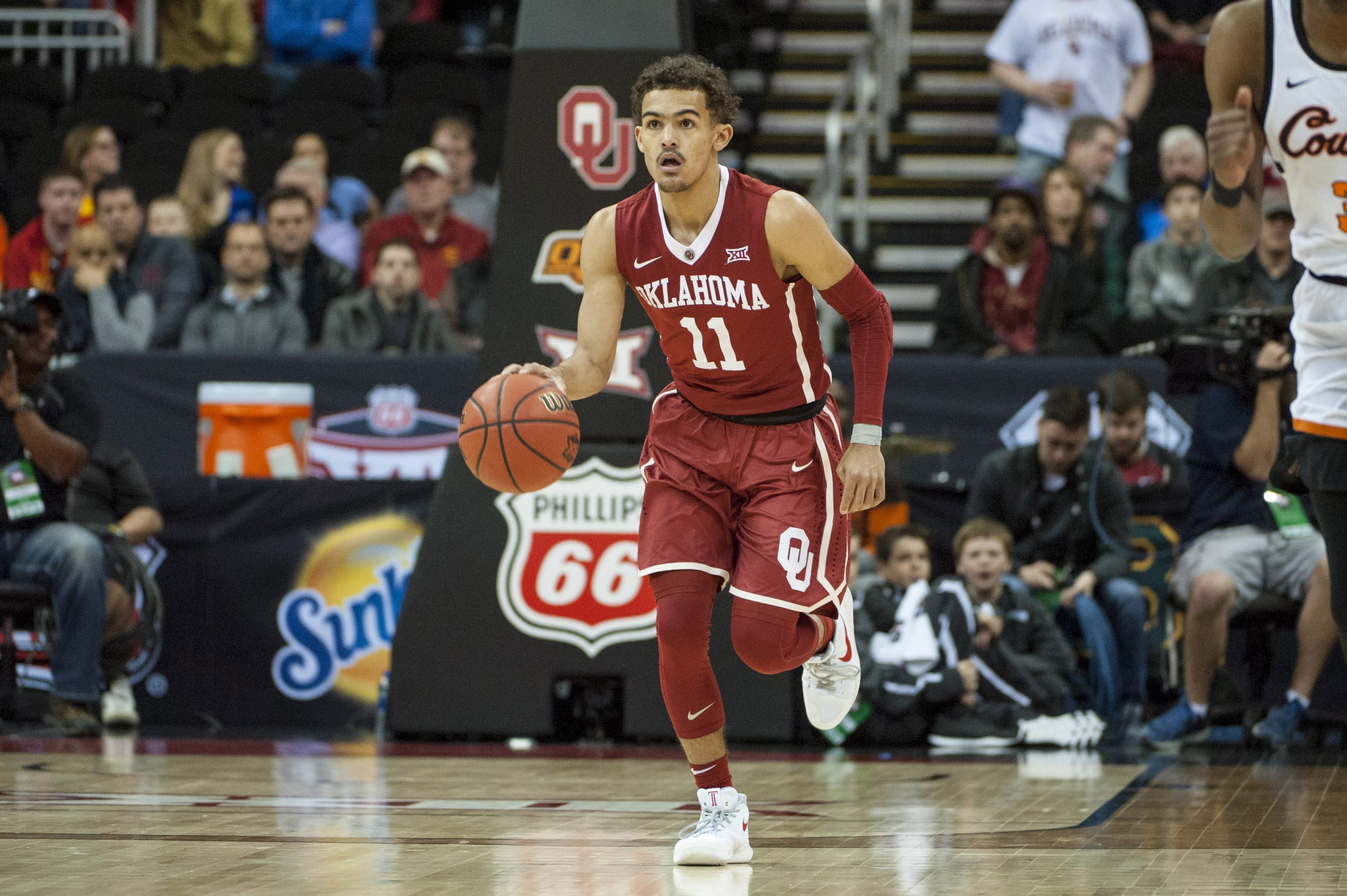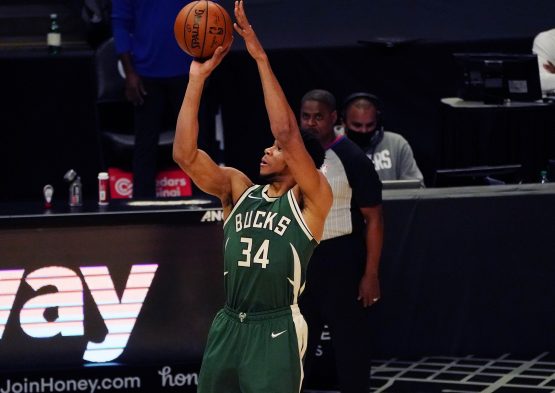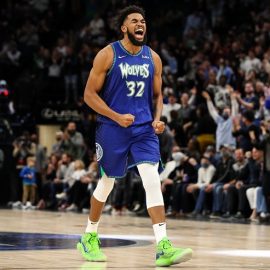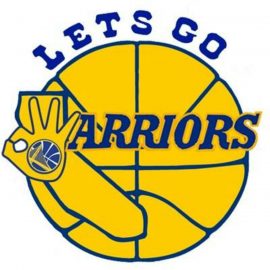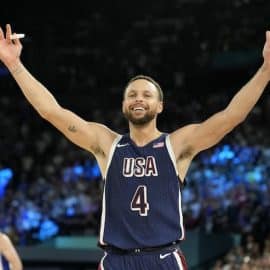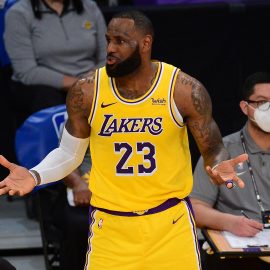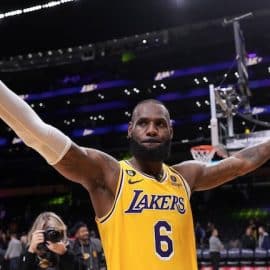For many non-Warrior fans, the NBA Finals was a massive disappointment. Thankfully for them, the NBA Draft and free agency are on the horizon. Before committing to this article, you should know that this is NOT a mock draft, NOR is it a big board. Those are both interesting exercises: trying to predict where players will be taken, and ranking players without regard for the draft order. However, I find it more fascinating, fun and worthwhile to consider who I’d pick at each spot if I were somehow the general manager for each of the 30 NBA franchises. Context matters. No player is an island, and it’s exceedingly rare that a player is so fantastic that team fit or structure should be completely ignored. Without further ado, let’s get to it.
1. Phoenix Suns: Jaren Jackson Jr.
After winning the top pick in the draft for the first time in franchise history, Phoenix is feeling the pressure to make the right choice. Select the best player from the 2018 class and the Suns are on the fast track to contending for their first title. Miss badly and they can probably start counting the summers until Devin Booker says goodbye for greener pastures. Hiring Igor Kokoskov, who coached Luka Doncic with the Slovenian national team, suggests that the Don(cic) is the favorite to land in the desert. Devin made strides as a passer this past season (4.7 assists per game on 3.6 turnovers), but Doncic could unlock the best in Booker, freeing him to hunt for buckets galore. Then there’s Deandre Ayton, who suited up for the University of Arizona this past season. And for most folks, this is a two-man race.
But in my opinion, Jaren Jackson Jr. is the pick here. He’s far and away the best defensive prospect in the draft, and very arguably boasts the highest floor as well. I don’t buy the narrative that suggests his ceiling isn’t as high as [insert name]. The Suns owned the league’s worst Defensive Rating (116.3). The next worst defensive club during the regular season was the Cleveland Cavaliers (113.9). In other words, Phoenix’s defense is a dumpster fire, and there’s really no clear path toward changing that unless they go with Jackson. Moreover, Jackson is a highly capable offensive player who’s not as raw on that end as some say. Draining triples and attacking closeouts off the dribble are just two of the offensive areas where he already excels. He even showed off some advanced handles here and there, most notably (in my mind) a crossover, step-back three while playing catch-up late in a loss versus Michigan. Jaren wasn’t able to showcase his offensive talents on a regular basis operating next to traditional center Nick Ward, but Triple J is versatility personified, a perfect fit for the modern game on both ends of the court.
To read my profile on Jackson (which include a K.G. comp), click here.
2. Sacramento Kings: Luka Doncic
Defensively, Doncic reminds me of a cross between Kevin Love and Kyle Korver. He’s a strong dude with a good base. His head is almost always on a swivel. And his instincts are solid as well. Nevertheless, he would still exacerbate the defensive issues Phoenix is already suffering from. Moreover, Devin Booker made serious strides as a playmaker while Josh Jackson and T.J. Warren remain most comfortable with the ball in their hands. Regardless, Doncic would likely fit in seamlessly on offense in Phoenix. But there’s little reason to think he can put out the flames on the other end of the floor.
Prior to the NBA Draft Lottery, De’Aaron Fox said the Kings need someone who can slow the high-scoring wings (on a Ringer podcast with Kevin O’Connor). If Sacramento snags Doncic, Fox would almost certainly need to become that stud-stopper, a-la Alana Beard of the Los Angeles Sparks or Jrue Holiday of the New Orleans Pelicans. Nevertheless, the Kings should opt to further embrace their already-entrenched European identity here, especially if Jackson is gone. Sacramento and Phoenix represent fine offensive fits for Doncic, with both former Kentucky Wildcat guards theoretically easing Luka’s load as a playmaker while also making it less important for him to be able to create his own shot all the time. Fox doesn’t have Booker’s jumper, but he’s already a better defender and distributor. I’m higher on Fox than most and I’m lower on Ayton than most. To me, that combo is somewhat intriguing since it goes against the grain (stud defensive point guard and offensively-inclined big man). However, it smells too much like the recent failed experiment in Orlando featuring Elfrid Payton and Nikola Vucevic.
To read Ilia Shatashvili’s scouting report on Doncic, click here.
3. Atlanta Hawks: Mohamed Bamba
Bamba has long been one of my favorite prospects in the class. There are legitimate questions about whether he will be able to slide his feet and cover along the perimeter as well as recover to the paint after stepping outside on PnR’s. Regardless, I’m taking Mo here because of his insane ceiling (and the fact that there’s no ceiling he can’t touch). Atlanta’s rebuild has only just begun. They can afford to be patient, and that’s exactly what will be required if they select the man who put the long in Longhorns for the University of Texas this past season. When it comes down to it, I’m taking the high defensive upside big over the offensively impressive center almost every time, and this is not a case where I’d make an exception. Hawks head coach and former Sixers assistant Lloyd Pierce knows a thing or two about working with talented young centers. Joel Embiid spent ample time bonding with Bamba as well, plus there’s the Drew Hanlen effect. This Sixers and Hawks connection warrants a Dikembe Mutombo shout out. I really like the idea of pairing Bamba with Taurean Prince at the 4 and then bringing John Collins in off the bench as a high-energy contributor.
To read more of my thoughts about Bamba, click here.
4. Memphis Grizzlies: Miles Bridges
The Grizzlies are at a fork in the road. There will undoubtedly be at least one highly-touted big man by the time they are on the clock, and it’s fairly likely that two of Jackson, Bamba, Ayton and Bagley are still available at fourth overall. That or Doncic could fall into their laps. Moreover, Memphis owes Boston its 2019 first-rounder (top-7 protected). In the very unlikely event that things play out on draft day as they have in this post, the actual Grizzlies would probably be choosing between Ayton and Bagley, with the former being the heir apparent to Marc Gasol and the latter potentially being able to fit alongside the former Defensive Player of the Year. Bagley is the obvious fit pick as the smooth lefty scoring sensation since Gasol thrived for what felt like forever playing next to Zach Randolph. Meanwhile, Ayton would signal a shift in vision for the Grizzlies, one focused on the future, as an Ayton-Gasol frontcourt duo is at least a couple light-years late to the party.
During the draft combine, head coach Bernie Bickerstaff spoke about the importance of maintaining the team’s identity. Enter Miles Bridges, the perfect player type to help the Grit N’ Grind Grizz evolve from cave men into small-ballers in the blink of an eye. Bagley might take a while to develop into a guy who contributes to a winning basketball team. Meanwhile, Miles may be ready to fill a starting role and contribute positively on both ends from day one. Even as traditional centers become fewer and farther between, the power forward position remains the swing spot in a lineup. Rotations with two traditional big men operating next to one another tend to put either the offense or defense at a severe disadvantage. Rudy Gobert and Derrick Favors are a devastating defensive duo, yet they still have a tough time chasing elite perimeter players around. The even bigger problem for Utah is on offense, where the court shrinks since opposing defenses will gladly allow those two to take as many shots as they please (besides layups and dunks).
I don’t think it’s that far-fetched to suggest the Grizzlies will be better off on both ends of the court if they go with Miles over Marvin or Deandre here. If Memphis really wants to milk Mike Conley and Marc for all they are worth and give those two the best chance to compete for a playoff spot once again, a fusing of the past and present seems necessary. A uniquely talented and versatile forward, Miles Bridges is a bulldog boasting the toughness, skills and intangibles to make the Memphis fan base fall in love.
To read Ilia’s draft profile on Miles Bridges, click here.
To read Chris Molicki’s recent column on the Grizzlies, click here.
5. Dallas Mavericks: Wendell Carter Jr.
Rick Carlisle prefers his centers to be smart and steady when it comes to protecting the paint and doing their job on defense. Wendell Carter fits that description. Wise beyond his years, the Al Horford play-a-like can take hold of the starting center role from day one, bringing his solid shooting, passing, finishing and defensive instincts to Big D. Carter is about as well-rounded as centers come, and he’ll likely be one of the biggest steals of the draft if he falls much farther than fifth. I wouldn’t blame Atlanta if they snagged him at third based on how well the Horford Era went.
6. Orlando Magic: Trae Young
With a long, athletic frontcourt featuring Jonathan Isaac and Aaron Gordon, Orlando should swing for the fences on Young and hope they can collect enough elite stoppers to help protect him on defense. It’s unlikely that Trae will ultimately reach Steph Curry’s level on either end, especially on defense.
Nevertheless, the Magic need an offensive initiator, and Young is that. I’ll go out on a limb and say that Young’s career will more closely resemble Curry than Jimmer Fredette. Trae’s shooting off the dribble and playmaking abilities are both much better now than Steph’s were at his age, and while he doesn’t boast Curry’s length, there’s a visible path toward him becoming an All-Star. Fear of missing out is a factor with Young, which is why I wouldn’t be surprised if he ends up hearing his name called as early as third overall.
To read Justin Yoon’s prospect projection for Young, click here.
7. Chicago Bulls: Zhaire Smith
The young Bulls need someone who likes to get after it defensively, and they can afford to take a shot on a young player with star potential. Deandre Ayton and Marvin Bagley both fit terribly on defense next to Lauri Markannen, while Zhaire should study Chicago legends like His Airness and Dennis Rodman in great detail. I don’t think it’s far-fetched to suggest that Smith could become the best player from this class if he develops a reliable perimeter jumper. Given how much he improved in between his senior year in high school and the end of his freshman year at Texas Tech, no one should be overly confident about doubting the former Red Raider.
To read more of my thoughts on Zhaire Smith, click here.
8. Cleveland Cavaliers (via Brooklyn): Deandre Ayton
Ayton won’t be enough to convince King James to keep his talents in Cleveland. Nevertheless, this a gamble worth taking with Deandre still on the board, as the Cavaliers will need a new potential franchise player to build around, especially if/when Kevin Love leaves. I’m much lower on Ayton than most, but still couldn’t allow myself to let him fall past eighth in my draft.
To read more of my thoughts and comparisons on Ayton, click here.
9. New York Knicks: Marvin Bagley III
I’ve gone back and forth between Bagley and Ayton, and ultimately it came down to fit. Cleveland going with Ayton allows them to move Love back to power forward full-time, while the Knicks snagging Bagley provides them with a younger, sprier version of Michael Beasley who would be better off playing the 4 next to superstar center Kristaps Porzingis.
To read my scouting report on Bagley, click here.
10. Philadelphia 76ers: Mikal Bridges
Mikal might not be as comfortable putting the ball on the floor as Michael Porter Jr. And the Sixers were lacking in offensive initiators during their playoff loss to the Celtics. No matter: I’d go with Bridges here. Philly still has Markelle Fultz finding his form, and they badly need more wings to flank Robert Covington and J.J. Redick (if he returns). Mikal should be able to slot in at the 2 and 3 as one of the first guys off the bench regardless of what the Sixers accomplish in free agency. Bridges was among the best defenders at the college level, and while he needs to get stronger to bang with the bigger wings in the NBA, his 3-and-D skill set will likely translate right away.
To read more of my thoughts on Mikal Bridges, in which I say that if he falls to 10th overall, NBA GM’s haven’t learned a thing over the last half-decade (whoops!), click here.
11. Charlotte Hornets: Michael Porter Jr.
There are legitimate questions about Porter’s ability to impact the game outside of scoring. That is what he was most well-known for in high school, and that’s all he really tried to do when he came back at the end of the year at Missouri — despite admittedly being less than 100 percent healthy. Potential health concerns notwithstanding, Porter fills a need at power forward for the Hornets and could provide immediate value as a floor-spacing 4 if Charlotte decides not to blow things up and trade Kemba Walker.
12. Los Angeles Clippers (via Detroit): Shai Gilgeous-Alexander
Gilgeous-Alexander could end up being a massive steal. Shai has shown shades of Shaun Livingston with a decent three-ball (small sample size), and if his jumper pans out, he could be the best point guard from this class.
To read Justin’s thoughts on SGA, click here.
13. Los Angeles Clippers: Kevin Huerter
Looking at L.A.’s roster, it’s fairly well-rounded if DeAndre Jordan picks up his player option ($24.1M) or re-signs. The one thing that’s been missing since J.J. Redick left for Philadelphia is a knockdown three-point shooter. Huerter can certainly hit the trey, and he has pretty good passing vision too.
To read Ilia’s scouting report on Huerter, click here.
14. Denver Nuggets: De’Anthony Melton
Melton is rising in mock drafts thanks to his size, athleticism, defensive potential, and overall upside. He could wind up playing up to three positions and sharing ball-handling duties with Jamal Murray on a Nuggets team that doesn’t have a designated point guard, but instead shares the ball-handling and playmaking responsibilities fairly evenly across the board.
15. Washington Wizards: Robert Williams
Williams would be an acceptable answer to John Wall’s calls for a young, athletic big that can catch and finish on offense and defend the rim on the other end. In other words, all the things Washington thought they were getting when they inked Ian Mahinmi back in the summer of 2016. Williams could become the Clint Capela of the class, and I wouldn’t be surprised if he ends up outshining at least one or two of the big men drafted ahead of him.
16. Phoenix Suns (via Miami): Lonnie Walker IV
Walker is one of the tougher prospects to evaluate in this draft class. He missed the beginning of the season coming off a torn meniscus and didn’t hit his stride until late in the year, so his stats aren’t impressive to say the least. With that being said, he’s an excellent athlete with more than enough upside to be worthy of a mid-first round selection.
17. Milwaukee Bucks: Donte DiVincenzo
Milwaukee went with a theoretical stretch-4 in D.J. Wilson during last year’s draft. While I was admittedly fairly high on Wilson, he did not do all that well in the G League this past year, and the Bucks might be better off going after a guard or a wing here. Thon Maker, John Henson and Giannis Antetokounmpo can eat up all the minutes at center with Giannis, Khris Middleton, Malcolm Brogdon, Tony Snell and Sterling Brown rounding out the wing rotation and Eric Bledsoe spending all of his minutes at point guard. DiVincenzo is an incredible athlete with good vision who can do a bit of everything. A couple years from now, DiVincenzo and Brown could round out the starting five (alongside Antetokounmpo, Middleton and Brogdon).
To read more of my thoughts on DiVincenzo, click here.
18. San Antonio Spurs: Troy Brown
Brown feels like a Spurs guy through and through. And he’s a safeguard against the potential departure of another phenomenal passing forward with an equally questionable outside shot (restricted free agent Kyle Anderson).
19. Atlanta Hawks (via Minnesota): Josh Okogie
Okogie will need time to develop, especially as a ball-handler and playmaker. Still, he’s an explosive athlete with great length (7-0 wingspan) and scoring ability who shot 38 percent on 4.2 three-point attempts per game this year.
20. Minnesota Timberwolves (via Oklahoma City): Jacob Evans
Minnesota needs more excuses to play small, and Evans is a strong defensive wing with good handles who can pass, shoot and make plays off the dribble. Whether Jamal Crawford re-signs or not, Jacob Evans is a fine fit.
21. Utah Jazz: Kevin Knox
As good as Derrick Favors has been, the Jazz should at least consider finding an eventual replacement at power forward – even if Flava Fav re-signs. Knox could be a steal at this spot as a floor-spacing, scoring 4 next to Rudy Gobert. The last time Utah picked a power forward (Trey Lyles), they ended up turning him into Donovan Mitchell. Knox likely won’t fall this far in the actual draft, but if he does, Utah should strongly consider him here.
To read Ilia’s profile on Knox, click here.
22. Chicago Bulls (via New Orleans): Elie Okobo
Okobo offers upside galore as a sweet-shooting, pick-and-roll point guard with good length (6-8 wingspan), instincts and two-way talent. I don’t see Kris Dunn as a starting point for a strong playoff team, so rolling the dice on a point guard prospect who fits Hoiberg’s mold makes sense for Chicago.
23. Indiana Pacers: Kenrich Williams
The upstart Pacers were downright abysmal when Thad Young was on the bench this season, so bringing in an experienced power forward with legitimate 3-and-D skills and passing ability would be wise.
To read more of my thoughts on Kenrich Williams, click here.
24. Portland Trail Blazers: Keita Bates-Diop
I have my doubts about whether KBD will be able to reliably cover the quicker guards and wings in the league. But the Trail Blazers need help now, particularly in the form of a forward who can put the ball in the basket.
To read Ilia’s profile on Bates-Diop, click here.
25. Los Angeles Lakers (via Cleveland): Mitchell Robinson
Robinson boasts no shortage of upside as a big man with a gorgeous jumper and good size, speed, quickness, and defensive potential. He’s enough of a mystery box that I have my doubts about him, though I could definitely see Mitchell sneaking into the late-lottery portion of the draft.
26. Philadelphia 76ers: Aaron Holiday
Having proven his worth in both on- and off-ball situations at UCLA while showcasing defensive tenacity and good length (6-7) for a guard, Aaron becomes the youngest of three Holiday brothers to suit up for the Sixers.
To read more of my thoughts on Holiday, click here.
27. Boston Celtics: Grayson Allen
I’m going with Grayson here because he’s the modern-day Danny Ainge.
28. Golden State Warriors: Shake Milton
For a point guard, Milton doesn’t make much happen off the bounce. That probably won’t get in the way of Shake enjoying a 10-plus-year career as a multi-positional perimeter defender with good length, savvy, shooting ability, and secondary playmaking skills. And his lack of elite handles or explosiveness as a driver won’t hurt his odds of thriving in Golden State.
29. Brooklyn Nets (via Toronto): Rawle Alkins
The Brooklyn native will bring two-way talent and toughness along the wing for a team that’s still trying to establish an identity.
30. Atlanta Hawks (via Houston): Collin Sexton
Sexton is a player that I personally enjoy watching. It’s not hard to tell he plays with a chip on his shoulder, and I believe in the Pat Beverley comps. My feeling is that Collin is a worthy first-round pick, but a lottery selection could result in him being viewed as a disappointment unless his outside shooting and distributing abilities drastically improve at the next level.
To read Ilia’s thoughts on Sexton, click here.
SECOND ROUND
31. Phoenix Suns: Bruce Brown
Having drafted Lonnie Walker at 16 (and Davon Reed at 32nd overall last year), the Suns should keep rolling with the University of Miami Hurricanes. After missing the second half of his sophomore season due to injury, Brown projects as a hard-nosed, well-rounded defensive wing who would surely be considered a second-round steal if his shot comes around.
32. Memphis Grizzlies: Chandler Hutchinson
Despite being a late bloomer, Hutchinson supposedly has traction as a potential late-first-round pick. It wouldn’t surprise me if he proves himself to be a solid role player. But to answer your question, yes, I was heavily influenced by the fact that this would give the Grizzlies two Chandlers.
33. Atlanta Hawks: Kevin Hervey
At 6-8.5 with a 7-3 wingspan, Hervey is a physical specimen of a stretch forward who has to sharpen his game around the edges. He’s not shy when it comes to scoring the ball (20.5 points on 16.5 shots per game as a senior), though he could stand to improve from beyond the arc and on defense. He also averaged 1.9 assists to 2.1 turnovers during his collegiate career.
34. Dallas Mavericks: Jarred Vanderbilt
Vanderbilt could be an interesting athletic small-ball center option for the Mavericks. Obviously, he fits their plan when it comes to getting up and down the court, and he has shown himself to be a sensational rebounder.
35. Orlando Magic: Khyri Thomas
Thomas offers the defensive quickness, length (6-10 wingspan), shooting and secondary playmaking to play a backup role for the Magic along the perimeter. Orlando will need a 2 just like Thomas to help protect Trae Young.
36. Sacramento Kings: Melvin Frazier
A defensive-minded wing, Frazier is precisely the type of player on Fox’s wish list. Melvin may take a few years to develop offensively, but he’ll step in and be one of Sacramento’s best perimeter stoppers, perhaps from day one.
37. New York Knicks (via Chicago): Landry Shamet
Shamet could eventually be the starter at point guard, operating alongside sophomore Frank Ntilikina. Like former Knick Landry Fields, Shamet is an unselfish, steady decision-maker who can defend and hit the three. It’s too early to tell, but Ntilikina may never be a full-time point guard, so investing in a sound playmaker who can handle the rock and defend is a smart call.
38. Philadelphia 76ers (via Brooklyn): Dzanan Musa
Given how many players the Sixers have under contract (and their lofty free agent hopes), I have them going international with every pick in round two. Musa is a good fit as a stash option for Philly thanks to his outside shooting.
39. Philadelphia 76ers (via New York): Isaac Bonga
A big guard with an inconsistent but decent shooting stroke, Bonga is worth a look for the Sixers as they continue to stash talent overseas.
40. Brooklyn Nets (via L.A. Lakers): Justin Jackson
Even after missing most of the year due to a torn labrum (appearing in just 11 games), Jackson is still intriguing enough to warrant someone taking a chance on him in the second round. At 6-7 with a 7-3 wingspan, Jackson could eventually be a guy who can cover all five positions.
41. Orlando Magic (via Charlotte): Anfernee Simons
Named after Anfernee “Penny” Hardaway, Simons perhaps unsurprisingly has good size for a combo guard with his level of handles. This a guy who could make me look foolish for ranking him this low. Nevertheless, this is a deep draft class, and he’s fairly unproven compared to his peers.
42. Detroit Pistons: Vince Edwards
Vince may not have the quickest footwork defensively, but he’ll provide spacing and savvy to a squad that needs all the help they can get on the wing.
43. Denver Nuggets (via L.A. Clippers): Jevon Carter
Carter is another guy I enjoy watching a lot. To me, there’s not much of a difference between Jevon and Collin Sexton, besides of course Sexton’s ability to rise up and throw down explosive dunks and Carter’s ability to splash threes (2.1 makes per game on 39.3 percent as a senior this year).
44. Washington Wizards: Jalen Brunson
Brunson will bring a badly-needed dose of cool, calm and collected to the second unit. Tomas Satoransky filled in well while John Wall was sidelined for half the year. Still, another unselfish playmaker who can put the ball in the hoop would help ease the offensive burdens for Wall and Bradley Beal.
To read more of my thoughts on Brunson, click here.
45. Brooklyn Nets (via Washington): Omari Spellman
Spellman projects as a pretty good backup big man thanks to his shooting range and rebounding ability, and he offers a different look from Jarrett Allen.
46. Houston Rockets (via Miami): Devon Hall
Hall is worth a look here as a solid two-guard who can do a little bit of everything, including play defense and make the right play.
47. Los Angeles Lakers (via Denver): Devonte’ Graham
Graham fills a need at backup point guard behind Lonzo Ball. And he fits in well with the current Lakers and their unselfish style of play.
48. Minnesota Timberwolves: Gary Trent Jr.
The Timberwolves were among the worst three-point shooting teams in the league (last in makes per game – 8.0, 19th in percentage – 35.7). Trent might not be able to do much else besides score, but that’s what the doctor ordered.
49. San Antonio Spurs: Gary Clark
The Gary’s go back-to-back. Clark is another classic Spurs pick – a guy who just gets it (it being how to play basketball). Gary doesn’t have great size for a power forward or center, otherwise I’d have him as a fringe first-rounder.
50. Indiana Pacers: Ray Spalding
Spalding should be selected at some point, if only because he has one of the best names in the draft. The athletic big man could end up being a useful backup power forward/center with the right seasoning.
51. New Orleans Pelicans: Desi Rodriguez
Rodriguez is a guy you probably won’t see in many mock drafts. He’s a strong wing who puts the ball on the floor, scores from deep and plays with grit. He has shades of a sturdier Kent Bazemore, but with less bounce.
52. Utah Jazz: Sviatsolav Mykhailuk
Mykhailuk can shoot the ball, plain and simple. Very few four-year college players enter the NBA at age 21, so for as experienced as Svi is, he’s still young. Utah needs more shooters to help spread the floor so Donovan Mitchell can go to work.
53. Oklahoma City Thunder: Jerome Robinson
Robinson is an infusion of offense for Oklahoma City. As a junior for Boston College, Jerome averaged 20.7 points (on 48.5 percent) and made 2.3 threes per night on 40.9 percent shooting. The fact that he’s not much of a distributor won’t be a big issue on the Thunder, at least not when Russell Westbrook is on the court.
54. Dallas Mavericks (via Portland): Moritz Wagner
Wagner can pick up a few tricks of the trade from Dirk Nowitzki, and hopefully further hone that one-legged step-back we saw from him at Michigan. Wagner finished 11th in the shuttle run at the NBA Draft Combine, with the same three-quarter sprint time as Jevon Carter, Trevon Duval and Khyri Thomas, but did struggle in terms of his lane agility time. In other words, despite Wagner’s underwhelming length (7-0 wingspan), he might be quick enough (and skilled enough) to survive as a backup big.
55. Charlotte Hornets (via Cleveland): Trevon Duval
Duval is an exceptional athlete with explosiveness akin to Westbrook. While Trevon was a dreadful shooter at Duke, the Hornets need a backup point guard not named Michael Carter-Williams. Plus, this will help shift Malik Monk back to shooting guard, which is where he belongs.
56. Philadelphia 76ers: Issuf Sanon
The 6-4 Ukranian point guard is one of the youngest players (18) in the class.
57. Oklahoma City Thunder (via Boston): Malik Newman
Newman can score the ball, and the Thunder need wings who can do that in order to maximize the 2017 MVP.
58. Denver Nuggets (via Golden State): Chimezie Metu
I don’t believe in Metu much. However, he offers potential as a big man who could potentially slide his feet and protect the rim in small doses. That’s one of the few things lacking on Denver’s roster.
59. Phoenix Suns (via Toronto): Hamidou Diallo
If you believe that Diallo had a shot at being selected in the first round last year, he has to be one of the biggest (if not the biggest) losers among those who were on the fence and chose to withdraw from the draft last year. He’s still an incredible athlete though, so someone will likely take a shot on him in the latter stages of the second round.
60. Philadelphia 76ers (via Houston): Rodions Kurucs
I’ll let Ilia take this one, as I haven’t even watched a full game from Kurucs.
AND ONE FOR GOOD MEASURE
There are plenty of worthy players that did not make this list but perhaps should’ve, from Purdue’s Dakotas Mathias to Wake Forest’s Bryant Crawford. It would be surprising if there weren’t some players who slip through the cracks. That’s how the world works. Before we go our separate ways, one final player that interests me is Notre Dame’s former heart and soul.
Bonzie Colson – Colson missed two months of his senior season due to injury, but he still managed to post impressive per-game averages on the year.
[protected-iframe id=”c7e066e7c0709bf8bf1e9f2001d85e89-142507471-56121583″ info=”https://www.sports-reference.com/cbb/seasons/2015.html?utm_source=direct&utm_medium=Share&utm_campaign=ShareTool” style=”overflow:auto” class=”sr_share_wrap”]He is a very skilled offensive big man who plays with grit and determination. At 6-5 with a 7-0 wingspan, he’s only slightly smaller than Golden State’s do-it-all big man Draymond Green (6-7, 7-1 wingspan). Colson isn’t as impressive as Dray on defense – though he did average 2.2 blocks and 1.7 steals per night as a senior – nor is he on a remotely similar level as a passer. Bonzie is basically Draymond if you turned him inside out. If Colson extends his shooting touch to beyond the arc and proves capable of sliding his feet decently along the perimeter, he’ll be an extremely unique role player in the modern era, a blend of Green and his best friend, Charles Barkley.
Add The Sports Daily to your Google News Feed!
